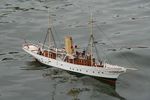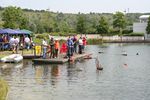.jpg)
.jpg)
.jpg)
.jpg)
.jpg)
.jpg)
.jpg)
.jpg)
Dear Dave
Our readers write to DAVID J. WIGGINS
Hello again vintage fans. This spring month I am sharing with you all another clutch of readers letters, beginning with a most interesting communication I received from Bill Jones of Carlisle back in 2007. Bill had been pleased with the first feature I presented on his E.D. 2cc penny slot diesel, an item dating from 1948 and published in our May 2007 issue.
The very first British diesels
In fairness to some of the others I must also say, that some of the early postwar diesels illustrated by Laidlaw Dickson that do not perhaps have famous names today were indeed still lovely looking things. Take for example the very Mills looking 4.4cc KEMP diesel (No. 9 in the Model Mechanic illustrations). It looks very workmanlike to me and Id have thought it had plenty of sales appeal. Ditto the tiny 0.9cc CLAN (No. 16), from Scotland. Quite pretty really, though I cant say the same of its big sister the 5cc CLANSMAN (No. 14), which looks antiquated and lumpy even for 1948. Of course, price must have been a big factor as to whether an engine succeeded or failed in those postwar years. There was so little money about then and the market was still small.
Made from Spitfires?
I was really pleased Bill sent me this stuff as I learnt a few things I did not know. Did you know for example that E.D. Ltds famous Competition 2cc diesel had, to quote: Crankcase metal from Battle of Britain Spitfires and is accordingly of a higher quality than would otherwise be unobtainable at anything like a modest selling price? So there you have it - I always thought of the Comp-Special as a rather clunky old long stroke plodder, but shall think of my own a bit differently now. I wonder which fighter squadron my Comp came from? So, thankyou Bill so much for this. You give us all a fascinating glimpse into a world of rationing and of recycled metal from a fighter plane that together with Camms Hurricane saved our bacon big time back in the 1940s. I shall ponder on that next time I pull over the start cord or flick a prop. on my tired out but dear old Comp.
A letter from British Columbia
Yes indeed John - I never flew a Slicker as I was interested in radio control from the start and Slickers were of course freeflight power jobs. My own KK fancy in those days was a Junior-60 (or the later Super-60), but I never got either because they were much too expensive for the young Dave.
One from Norfolk
Lez went on to question me about the E.D. Condor, a very early British example of the 10cc r/c glowmotor genre. I had a punt through my early volumes of RCM&E and this was first mentioned in an E.D. advert during late 1962 as a coming soon/in final stages of development item. Looking on through 1963 it never seems to have come on to the market and why, Ive no idea. Has anyone out there seen or owned one? Whatever, it is clear that the Condor was never any threat to the very successful British Merco 49 or their later 61 version which was a 10cc bored out derivative that was being trialed itself during 1963.
Another great thing (for me) about receiving letters from Lez is that he can type. I like getting readers letters and do try to answer them all, but some of the handwriting can be impossible. Often, I am forced to reply with a sort of generalised thanks, as I just cant read them. So well done Lez mate!
An image from yesteryear
Images from Yesteryear was one of my first series in the old Radio Control Boat Modeller magazine and rooting through my own clubs photo. archive recently (that is a posh word for a box of old snaps), I was amazed to find the group picture featured here that I can genuinely say I knew nothing about.
Almost as much fun as remembering the people is the gear. I actually built the public address amplifier and frequency monitor sitting on the table for example. In 1974 I had just begun an electronic engineering career in the service of the Crown and I suppose I was a natural choice to build anything electronic. The amplifier was built from a popular Mullard (they were a Dutch concern that manufactured valves and semiconductors) circuit diagram of the era and the monitor I developed myself, using the then popular Remcon Superhet receiver circuit as a basis and designed by an engineer called Geoff. Chapman, to which I simply added six switched 27MHz crystals and an audio amplifier. Both bits of kit worked well and lasted us for many years and to be honest, we could do with a 27/40 MHz monitor today as it seems to me that frequency discipline at the lakeside is worse now than it was then, plus there are a plethora of r/c toys and gadgets replacing the CB menace of the past and a general laziness in using pennants. There are plenty of ready made scanners on the market that would fill the bill and Maplin, as well as others, have a selection. Theres certainly no point building one nowadays.
Want the latest issue of Model Boats? Use our magazine locator link to find your nearest stockist!
 Make sure you never miss out on the latest news, product reviews and competitions with our free RSS feed
Make sure you never miss out on the latest news, product reviews and competitions with our free RSS feed

We welcome well written contributions from Website members on almost any aspect of Model Boating with a particular emphasis on practical hints, tips, experience and builds.
In order to maintain a consistent standard and format, all suggestions should first be sent to me by Personal Message for approval in principle. Only a very limited amount of time is available for editing contributions into a suitable format for placing on the website so it is important that the material is well presented, lucid and free from obvious spelling errors. I think it goes without saying that contributions should be illustrated by appropriate photos. I shall be happy to give advice on this.
The Member Contribution area offers space for short informative mini articles which would not normally find a place in Model Boats magazine. It is an opportunity for Website Members to freely share their expertise and experience but I am afraid that virtue is its own reward as there is no budget to offer more material recompense!
I look forward to receiving your suggestions.
Colin Bishop - Website Editor
Model Boats Magazine
- Landing Craft Mini PLan
- Riva Aquarama Build
- Scale Colour, Sound & Speed
Digital Editions
- Access your digital editions
Subscribe Now
- Every issue delivered right to your door
Renew Now
- Save & never miss an issue!














 Register
Register Log-in
Log-in



